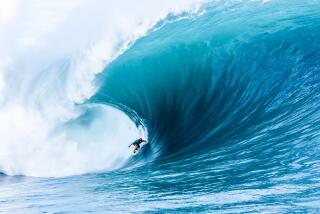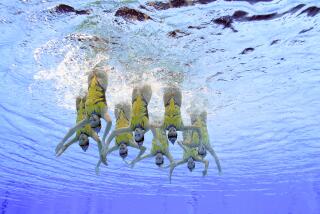Wetsuit Won’t Keep Surfers in Stitches
- Share via
Basic wetsuit design hasn’t changed much since California surf and diving pioneers invented them in the 1950s. Most manufacturers still cut the neoprene rubber by hand and whip up the suits on sewing machines.
That, says Jim Simpson, president of Costa Mesa-based EST Labs, isn’t such a good idea.
“You are taking an expensive piece of rubber and putting holes in it,” Simpson said, “which is exactly what it’s not supposed to have.”
Simpson’s company has come up with an invention that eliminates the hole-poking process--and produces a stitchless wetsuit. EST Labs says its suit is warmer, lighter, more flexible and more durable than suits that are sewn together.
The wetsuit industry apparently agrees. Rip Curl, Body Glove and Hurley have signed agreements to sell the EST suits, which are being produced in Thailand. EST, which will not market its own brand of suits, says other companies will soon follow.
“It was incredibly flexible and there was absolutely no leakage,” said Ronnie Brim, director of wetsuits and accessories for Hurley. “That’s a huge thing.”
The stitchless wetsuits will have top-of-the-line prices when they hit retail outlets next fall. One of Hurley’s high-end suits, for example, costs $280, and the EST version will cost about $40 more.
Surfers who pay the price will be happier in the lineup, says Preston Murray, a former professional surfer and EST marketing employee. Without pinholes, very little water seeps into the suit until a wave crashes over your head.
“Any surfer knows,” Murray said, “that there’s nothing better than going out in the water and being able to wait 15 minutes before getting wet.”
EST was able to eliminate stitching because of the efforts of Richard Huber, an MIT-educated biochemist. Huber invented a system that cuts neoprene in a wave pattern with a laser and then bonds the material molecularly. The wave pattern creates more surface area for the bond and the resulting seam is stronger and more flexible.
COLD-WATER WINNERS
World junior champion Joel Parkinson of Australia won the first major professional surfing event of 2000, the O’Neill Cold Water Classic on Sunday at Steamer Lane in Santa Cruz.
Conditions for the final were tough, with wind, sporadic rain and six-foot, messy surf. Simon Nicholson of South Africa was second, Joca Junior of Brazil third and Jeff Deffenbaugh of Huntington Beach fourth.
Pauline Menczer of Australia won the women’s final, defeating countrywomen Kate Skarratt (second) and Serena Brooke (fourth) and France’s Maria Pierre Abgrall (third).
Joel Tudor of Del Mar won the longboard title, beating three San Clemente surfers, Josh Baxter, world longboard champion Colin McPhillips and Geoff Moysa.
Mick Fanning of Australia won the Pro Junior final. Mike Todd of Laguna Beach was second, Roy Powers of Hawaii third and Mike Losness of San Clemente fourth.
MARATHON WOMEN
Two Orange County women will go for one of three spots on the U.S. Olympic marathon team Saturday in Columbia, S.C.
Kathy Smith of Irvine and Kelly Flathers of Huntington Beach are among the 210 who have qualified for the trials by finishing a marathon faster than 2 hours 50 minutes in the last 12 months.
Smith, 33, also ran in the 1992 and 1996 Olympic trials. Flathers, 28, is making her first appearance.
MASTERING TRACK
The Saddleback Masters Relays track and field meet is Saturday on the all-weather track at Saddleback College.
The first event--the 5K race walk--is at 8 a.m. The field events start at 9 a.m. and the introductions of Olympians and special guests are at 12:30 p.m.
Details: Doug Smith (949) 831-5935.






